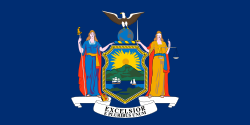 | |
| New York State public benefit corporation overview | |
|---|---|
| Formed | 1965 |
| Jurisdiction | Administration of the New York Sire Stakes races, Excelsior/State Fair Series races, and County Fair Races |
| Headquarters | One Broadway Ctr. Schenectady, NY 12305 |
| New York State public benefit corporation executive |
|
| Website | www |
The Agriculture & New York State Horse Breeding Development Fund is the public-benefit corporation responsible for administering the New York Sire Stakes.
Contents
The Agriculture & New York State Horse Breeding Development Fund was established in 1965 [1] to promote the breeding of horses and the conduct of equine research within New York State. As part of its mission, the fund administers the state's Sire Stake's program, provides assistance to county agricultural societies, and provides annual grants to the statewide 4H program as well as the Zweig Fund for Equine Research. It also administers the Excelsior/State Fair Series races and County Fair Races.
